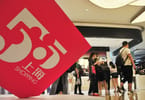The production of Champagne dates back hundreds of years, and the accumulated know-how and substantial public relations have made France and French products one of the most emblematic “wine countries” on the planet.
France is the only place in the world where a thirsty drinker can find the grapes, and the vineyards that produce Champagne.
France and wine are synonymous as the product is an integral part of the country’s agricultural, food and cultural history and identity.
In 2018, France had approximately 786,000 hectares of vines, with a product of almost 46.4 hectoliters, making France the second largest producer of wine in the world by volume, just behind Italy. French production represents 16.5 percent of world wine production. From a surface perspective, one out of every 10 hectares of vines in the world is located in France.
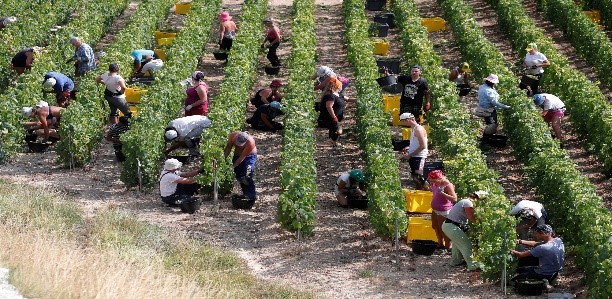
Economic Engine
The wine sector employs nearly 558,000 people, including 142,000 winegrowers, and approximately 84,000 are members of one of the 690 French cooperative cellars creating 300,000 direct jobs, 38,000 merchants, 3,000 sommeliers, 100,000 wine merchants, and 15,000 employees in the wine departments of supermarket distribution. Two-thirds of French wine production is consumed in France and 85 percent of French households (23 million) consume wine at home (2017).

Almost 10 million wine tourists (42 percent from abroad) visit the 10,000 French wine tourism cellars or the 31 museums dedicated to wine in France.
Sending Wine Abroad
France is the world’s largest exporter of wine (standing in front of Italy and Spain) with 29 percent of total value making it a strategic product for French exports. In 2018, France exported nearly 14.9 hectoliters for nearly 8.9 billion Euros (the equivalent of more than 100 Airbus aircraft). French exports are primarily (about 60 percent) destined for European countries, led by Germany and the United Kingdom; however, the main destination for French wines is the USA (16 percent of total value exported, mainly in bottles).
French Define Wine
In 1907 wine was legally defined in France as a fermented drink in which all elements must come from grapes, including water and especially flavors. The objective: to prohibit any illegal production likely to artificially increase production and risk causing wine prices to decline.
Internationally wine has been defined (1973) by the International Office of Wine (OIV) established in 1924 as “exclusively the drink resulting from the complete or partial alcoholic fermentation of fresh grapes, crushed or not, or of grape must. Alcoholic strength may not be less than 8.5 percent by volume.”
The French wine sector is the first to have based its development on the designation of origin, preserving the expression of the terroir that excessive productivity would dilute. From an economic point of view, the tendency to prefer wines that are constrained in their yield guards against the risks of overproduction and price collapse.
Producers of champagne ardently control the production process, protecting the reputation of the sparkling wine as a unique commodity.
Champagne was the first region to be awarded an appellation (controlled delimitation) by the French state. The notion of delimitations became increasingly important in the early 20th century as champagne is important to the French national identity and helps to establish the ways in which terroir and the system of controlled appellations preserve a particularly French genealogy.
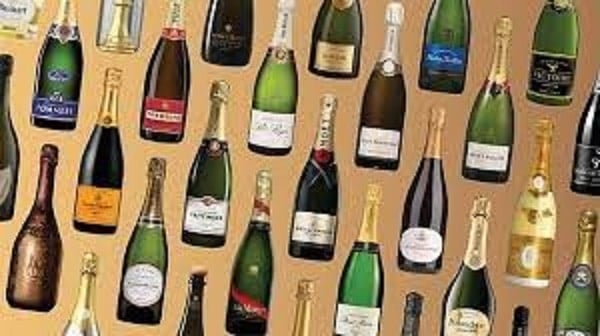
Champagne. Unintended Consequence
History suggests that sparkling wine was “born” by accident – the production of carbonic gas emerging from a secondary fermentation of yeasts. Many wines can “sparkle,” however, Champagne producers focus on the up-market potential of the sparkling beverage, working hard to promote the distinctive qualities that hark back to aristocratic genealogies and myths of patrimony, linking the beverage, the place and the producers to a unique and up-market past.
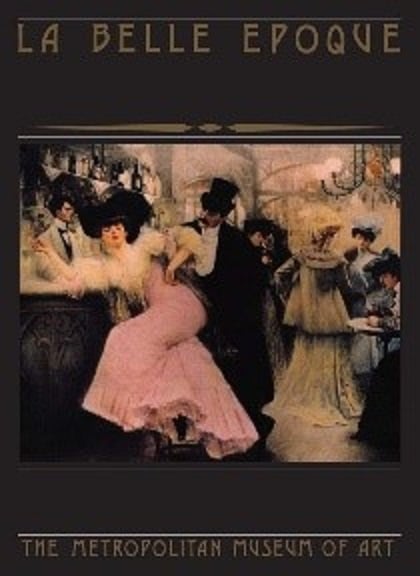
By the Belle Epoque (1871–80), to drink champagne was to stake your claim to a civilized life. It became a national brand in an international market, a commodity with tremendous symbolic, and cultural capital.
Champagne is a Blend
Champagne is a blended wine, and large family estates dominate with negociants responsible for crushing, blending, aging, and marketing the wines. Grapes and soil were the growers’ only means of controlling the appropriation of Champagne. The phylloxera epidemic of the 1890s threatened vignerons and negociants leading to the legitimization of the idea that Champagne as a defined region was fundamental to the identity of Champagne as a national and international beverage.
There has always been tension between the grape growers and the negociants. The growers sell about 23 percent of all bottles of Champagne, but over 92 percent of these sales are made in France. Many of the vignerons are members of one of the 137 cooperatives in the region, and designed to provide small scale producers with access to capital that they could not access individually and to strengthen their bargaining power in face of the superior economic power of merchants and middlemen. There are more cooperatives in Champagne than any other French wine region, and they are set up to process grapes, and sell juice or still wine to the houses.
There are four basic ways of handling grapes:
1. Press and sell juice
2. Make a still wine which is sold
3. Put the still wine through second fermentation in bottle and then sold
4. Put the still wine through second fermentation in bottle and sell to others for marketing as their own product
5. Produce an effervescent wine sold under their own label in competition with the negociants and other growers
Ụdị Champagne
Five groups currently control most of the Champagne market.
1. Moet-Hennessy Louis Vuitton (LVMH) (largest in the luxury space):
• Moet et Chandon (1743)
• Veuve Clicquot (1772)
• Krug (1843)
• Ruinart (1764)
• Mercier (1858)
Others groups include:
2. Vranken Pommery (1858), BCC which owns:
• Lanson (1760)
• Boizel (1834)
• deVenoge (1837)
3. Laurent Perrier (1812) includes:
• Salon (founded in 1911). One of the most prestigious houses in Champagne. Instead of making a range of styles that includes a prestige cuvée like most Champagne houses, Salon makes a single prestige cuvée, which is made entirely from Chardonnay from the village Le Mesnil-sur-Oger.
• Delamotte (1760)
4. Pernod Ricard (multinational drinks group)
• Mumm (1827)
• Perrier Jouet (1811)
5. Remy Contreau
• Charles and Piper Heidsieck (1851)
17 medium sized enterprises account for 33 percent of value:
• Taittinger (origin 1734; Taittinger 1931)
• Louis Roederer (1833)
• Bollinger (1829)
• Pol Roger (1849)
The Nicolas Feuillatte (highest selling Champagne across French hyper and supermarkets in 2020) selling 4.5 million bottles, 2.6 million bottles more than the second most sold brand, Alfred Rothschld. The Feuillatte brand (started in 1976) brings together 80 smaller, more localized cooperatives into one enterprise, indirectly uniting approximately 6,000 of the vignerons in the region. Nicolas Feuillatte is the 4th-or 5th largest brand in the world by volume.
Two prestige cuvee Champagnes that started the trend continue to be important in the luxury market: Moet’s Dom Perignon, and Roederer’s Cristal. The House of Roederer started Cristal in the 19th century for the Imperial Court of Russia, and Czar Alexander II. The cuvee received its name from the unusual clear crystal bottle the czar insisted on using. Moet & Chandon, a very large producer, is a small percentage of Moet’s total production. The wine was first marketed in the early 20th century, exclusively in England, and the United States, becoming available in France in the mid-20th century.
Nke kacha na okomoko
Consumers perceive Champagne as a luxury and willingly pay premium prices for a product that costs approximately 9 Euros to produce (basic, non-vintage brut); it is smart marketing and quality consistency that has positioned it so successfully as both a symbol and a myth.
Studies indicate that Champagne is not a daily purchase in supermarkets.
Only (on average) 1.8 purchases per person, per year are made, as opposed to 5 purchases per person per year for sparkling wine as a whole (not including Champagne). The research also indicates that 60 percent of consumers drink Champagne for social or entertaining reasons, and the average age of a Champagne consumer is between 35-64, with a strong female following between the ages of 17-24.
Some markets are experiencing a decline in Champagne sales, and this may be the appropriate time to expand the marketing efforts beyond celebration, extravagance and seduction to broaden the options to aperitif and food friendly.
APVSA – Brings a New Champagne to New York

If you are wine buyer, importer, distributer, agent, wine writer/reviewer, sommelier or wine educator, you must meet with Pascal Fernand the founder of the Association pour la Promotion des Vins et Spiritueux (APVSA), a non-profit organization that links boutique winegrowers/winemakers with North American markets (including the USA, Mexico and Canada). Based in Montreal, Fernand has spent over 20 years introducing boutique wines, and spirits producers to new markets, and new consumers.
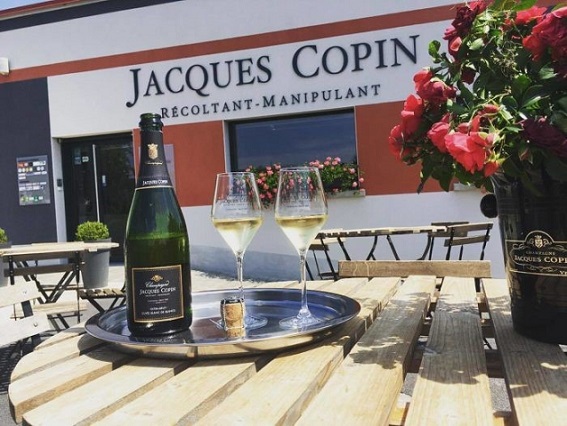
At a recent APVSA event in New York City, I had the good fortune to meet with Mathieu Copin, from Champagne Jacque Copin, based in Verneuil, France. Currently Copin Champagne is imported, and distributed in California, Puerto Rico, Japan, The Netherlands, Sweden, Denmark, Switzerland, Germany, Switzerland, South Africa and Cambodia.
The family owned, independent estate is located on a 10ha vineyard in the Marne Valley where some of the most interesting and unique Champagnes are produced. Pinot Meunier, a grape indigenous to the area, is a focus of Copin Champagnes.
The estate was started by Alfred Copin in the late 19th century when he purchased vineyards in Vandieres. The winery was passed on to Maurice Brio, and Auguste Copin who took on leadership roles as they planted the first vines of Chardonnay, and Pinot Noir. Starting in 1963 Jacques Copin expanded the Verneuil business with his wife, Anne-Marie, introducing the Champagne Jacques Copin brand.
Since 1995, Bruno and his wife, Marielle and their children, Mathieu and Lucille, are leading the Copin brand operations mixing tradition with modern technology. The vineyards are tended by hand and vinification takes place in oak barrels while thermo-regulated stainless-steel vats and micro-vinification allows the production of unique champagnes.
Personal Copin Favorites
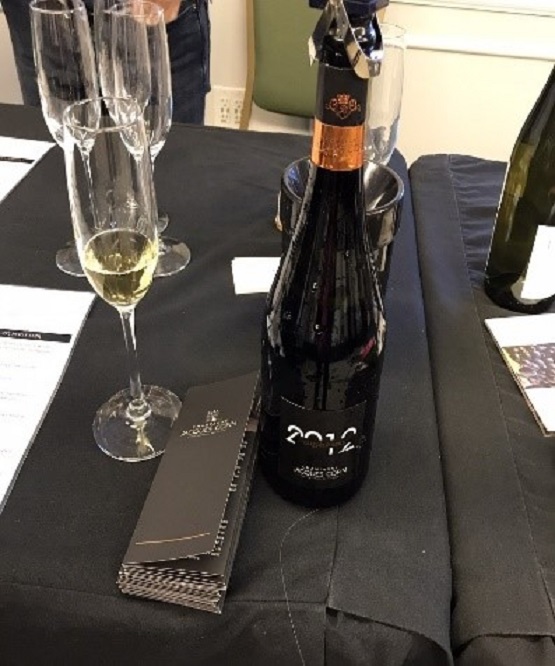
Copin produces many Champagnes and the following reflect my enthusiastic responses to a select few:
1. Polyphenols 2012. Extra Brut. 50 percent Chardonnay, 50 percent Pinot Noir.
Polyphenols (phonelic compound) are natural to grapes. They are present in the skin, offering color and aromas and considered beneficial to health. Professor Jeremy Spencer, Department of Food and Nutritional Sciences, University of Reading, finds that polyphenols have, “the potential to influence cognitive functioning such as memory…’ Other research from the University revealed that, “two glasses of champagne a day may be good for your heart and circulation and could reduce the risks of suffering from cardiovascular disease and stroke.”
The Polyphenols Copin grapes were manually harvested during September 19-20, 2012, and pressed within 6 hours; disgorgement occurred by freezing with jetting and no SO2 was added. The wine was bottled on March 8, 2013, in French made cinnamon colored glass from the O-I SAS France de Reims factory. There is no chilling or filtering; malolactic fermentation; no finings. Racking with alcoholic fermentation: Active dry yeast set at up to 17 degrees C in steel vats. Cellar aged for at least 108 months at 11 degrees C with a capped cork and P103 seal.
This brut, half chardonnay and half pinot noir delivers a delightful golden hue to the eye, ripe white fruit, green apples, plums, grapefruit, honey, and toasted notes to the nose, and then thrusts a unique and tantalizing structure to the palate that is underscored by marked acidity. Dense, complex and delicious, this champagne provides a long and happy finish. Pair with pork, salmon, tuna, shellfish or soft / mild cheese.
2. Rose Brut. 60 percent Pinot Noir, 25 percent Meunier, 15 percent Chardonnay from three Villages in the Marne Valley (Veneuil, Vincelles, Vandieres).
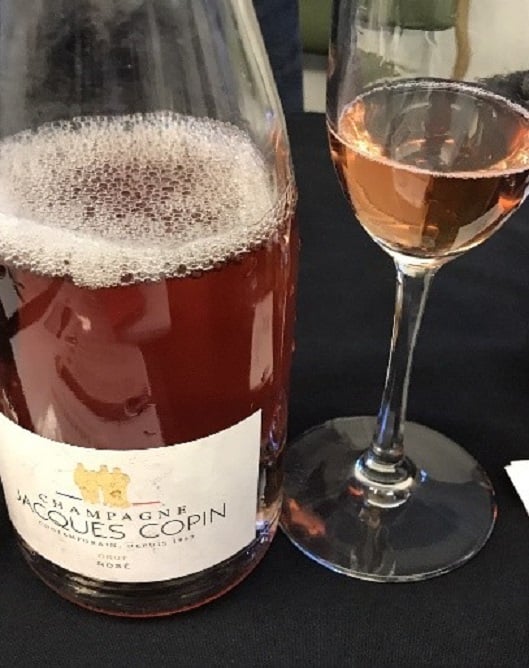
Sustainable viticulture with limited use of synthetic products. Manual harvest followed by pneumatic pressing. The partial fermentation is started at a low temperature in stainless steel tanks delivering an off dry wine with low alcohol content. The wine is then lightly filtered to keep the yeasts. Fermentation restarts naturally for a minimum of 2 months; the overpressure created in the bottle prevents new fermentation. The disgorgement is done by decanting the bottle under pressure, with a sterile filtration.
Deep coral pink to the eye along with lively bubbles. The nose is delighted with the soft aromas of fresh cherries and strawberries. The palate enjoys the discovery of red fruit balanced by herbs and light acidity. Enjoy as an aperitif or with crab cakes, duck, fish and chocolate-based desserts and fruit.
3. Le Beauchet Extra Brut. 100 percent Pinot Noir made from a blend of harvests from the 2012, 2013 and 2014 from the Beauchet plot. The vines were planted in 1981 with a 41B rootstock.
The plot is southwest facing, with a very low slope at the bottom of hills, predominantly clay-loamy soil with little limestone and very rich in iron. Grapes are hand-picked and pressed within 6 hours. Disgorgement by freezing with jetting with no added S02.
Bottled in March, April or May after picking, in lighter weight French made glass champagne bottles from O1 de Reims factory. No chilling or filtering. Racking after AF Malolactic fermentation not performed. No finings. Alcoholic fermentation. Active dry yeast Saccharomyces cerevisiae galactose at 18 degrees C in steel vats. Disgorgement date engraved on bottle base and cork; rests for 5-6 months before sale.
For additional information on wines available through APVSA, pịa ebe a.
© Dr. Elinor Garely. Enwere ike ịmegharị akụkọ nwebiisinka a, gụnyere foto, na-enweghị ikike ederede sitere n'aka onye odee ya.
#wines
#champagne
IHE Ị GA-Ewepụ na edemede a:
- The notion of delimitations became increasingly important in the early 20th century as champagne is important to the French national identity and helps to establish the ways in which terroir and the system of controlled appellations preserve a particularly French genealogy.
- Many wines can “sparkle,” however, Champagne producers focus on the up-market potential of the sparkling beverage, working hard to promote the distinctive qualities that hark back to aristocratic genealogies and myths of patrimony, linking the beverage, the place and the producers to a unique and up-market past.
- Internationally wine has been defined (1973) by the International Office of Wine (OIV) established in 1924 as “exclusively the drink resulting from the complete or partial alcoholic fermentation of fresh grapes, crushed or not, or of grape must.











